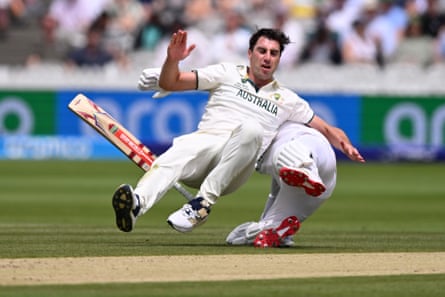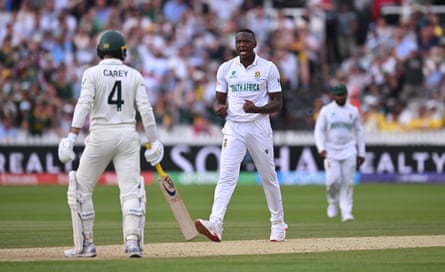You would have to call the combination incongruous. In one of the clips doing the digital rounds before the World Test Championship, there was Pat Cummins on Jeremy Clarkson’s farm programme, having apparently just raided the activewear section, the men around him wearing those vests that help rich people believe themselves to be rugged outdoor types. It’s hard to imagine much affinity between the two, sitting presumably at a wooden farmhouse table over Clarkson’s rustic bean soup and a heel of crusty bread, talking their way to a cordial entente about carbon emissions. But there was the Australian captain nonetheless, affably rolling an arm over while a farm type plonked a rubber ball on to a nearby shed, the bowler smiling in that way that suggests a shrug as Clarkson sledged him in a most British fashion.
By the second day of the World Test Championship final, affable Cummins was not in attendance. We’re used to that half smile, half shrug: even after some galling Test losses, Cummins has offered the perspective that the game is a game, that the players tried their best, and that losing is often the price of trying to win. He declines to be drawn into the hype that frames sport as everything. But this time was different, if only by a few degrees. It’s not that there was anger in the performance, but there was something uncharacteristically flinty.
Perhaps there was some influence from the pre-game chatter, much of which focused on Cummins on the one hand and Kagiso Rabada on the other, as their teams’ spearhead bowlers. The question came up several times: who is better? With a similar volume of Tests played, wickets taken, and averages a few tenths apart, it’s an interesting one to consider. It’s not the sort of thing that would exactly have upset Cummins, but the smiling captain is still highly competitive. Perhaps it gave him something to prove.
Rabada got first chance, double-striking early on his way to five for 51, passing Allan Donald’s wicket tally in the process to reach 332. Cummins went bigger and cheaper, six for 28 to reach an even 300. Kyle Verreyne’s wicket was one with a few sparks. There was the skill, a ball heading sufficiently towards leg-stump to beat the bat, but not enough to miss the wicket, foxing the umpire but not Cummins or the ball-tracking cameras.

But amid all that came a heavy collision, Cummins backpedalling in his appeal, Verreyne ball-watching as he attempted to run a leg bye. Normally you would expect Cummins to help an opponent up after finding his feet, but no hand was extended, his mind purely on the possible review. Australia didn’t run out Verreyne, which they were within their rights to do, but that was as far as courtesy went.
Then there was Rabada coming out to bat. Having taken five wickets to this point by pitching up – a classic back off the seam to hit the stumps, two mistimed shots befuddled by pace to give up catches in front of the bat, an in-nipper for lbw, an away-ducker for an outside edge – Cummins immediately spread the field and went short. A few balls later he hit Rabada on the body. A quick query about his health, a thumbs up, and the next ball was straight back at him, this time smashing him in the grille. Third time unlucky, Rabada pulled to the deep and was caught. It was uncompromising and, in the context, perhaps it was pointed.
After which, an hour into the second session, he wouldn’t have been expecting to be batting before the end of the day. But so it goes sometimes, on the Lord’s slope with heavy cloud and a general gloom that made the ball hard to see. It was Rabada to start with another double strike, and Marco Jansen to take out the other opening bat, but this time Lungi Ngidi got involved, three huge wickets through the middle order. The last of those was Cummins, two balls after smoking a drive for four, bowled by one that speared in at the pads and deflected back.
after newsletter promotion

Being 73 for seven is not a position that any Test team should find comfortable, but when the third innings has almost ended before the second day has, the calculus is different. Cummins had been among South Africa’s early chaos on the first evening. He had dislodged the only two obstacles on the second day, Temba Bavuma and David Bedingham. Then he had wrapped up the end.
It was a captain’s performance to give his team a 74-run advantage, huge in relative terms despite their own small first innings. That meant that with a repair job by Alex Carey in the second, removed by Rabada late in the day, even Australia’s faltering batting had given them a lead of over 200. South Africa have to believe that they can chase that kind of score, but on the evidence so far, it gives Australia every chance of a second World Test Championship win. Rabada still has a chance of 10 wickets in the match. Cummins still has a chance to reply.

 21 hours ago
9
21 hours ago
9

















































